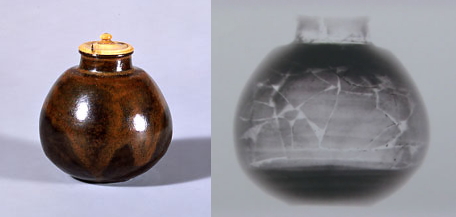Chinese pottery tea caddy TSUKUMO NASU
11th May 2015
The "Tsukumo-nasu" is a Chinese-imported ceramic tea container in the nasu ("eggplant" - rounded with a slightly larger bottom) style originally belonging to the third shogun of the Muromachi shogunate, Ashikaga Yoshimitsu (1358-1408). It is said that he even carried it to battle with him. After that it was handed down as a favorite possession through the Ashikaga family for generations. During the time of the eighth Muromachi shogun, Ashikaga Yoshimasa, it was passed into the care of Yoshimasa's master of tea ceremony, Murata Juko. The tea container began to be called “Tsukumo ninety-nine) nasu" because Juko paid 99 kan (an ancient form of Japanese currency) for it. After that it passed from owner to owner, ever increasing in value. By the time Asakura Soteki of Echizen got his hands on it it was worth 500 kan. Afterward Asakura entrusted it to the care of wealthy textile merchants in Kyoto, and it is theorized that this was to spare the piece from turmoil in the Echizen region. Around the year Tenbun 16 (1547) it came into the possession of Matsunaga Hisahide, an influential patron of Honkokuji Temple in Kyoto. The exact route it followed is unknown, but he is thought to have paid 1000 kan. However, Hisahide had no choice but to hand over the Tsukumo-nasu to Oda Nobunaga, who had come to Kyoto to pay homage to the shogun's younger brother Ashikaga Yoshiaki, after which he became one of Nobunaga's followers. It became one of Nobunaga's favorite items, and in the fifth month of Tensho 10 (1582) he took it with him to the capital. It was at his side when he was forced to commit suicide by his own retainer during the Honnoji Incident. Hashiba Hideyoshi (later known as the famous Toyotomi Hideyoshi) took it from the burnt ruins of Honnoji Temple, and it is thought that he passed it down to his son and heir, Toyotomi Hideyori. After that it was kept at Osaka Castle. It once again faced the flames of war during the siege of Osaka Castle in the summer of 1615. Tokugawa Ieyasu ordered a search of the ruins, but it was so badly damaged that it was given to a famous lacquer ware craftsman named Fujishige Togen and his son (also named Togen) for repairs, and after Ieyasu's death it as bestowed upon the Fujishige family as a gift, then passed down as an heirloom. During the Meiji Era it was acquired by Yanosuke Iwasaki of the Mitsubishi Zaibatsu. It is said that Yanosuke borrowed money from his older brother to purchase it.
width: 7 cm
tall: 6 cm
origin: China
age: 12-13c
collection: Seikado art museum
